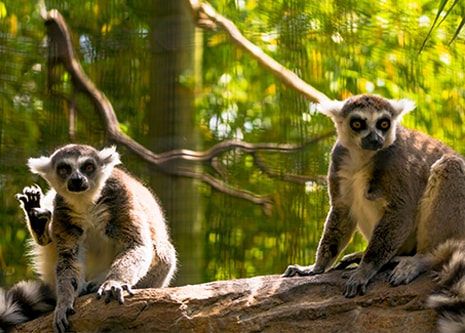
- VisitSupport Happy HollowDONATE TODAYExploreSupport Happy HollowDONATE TODAYLearnSupport Happy HollowDONATE TODAYSupport
-
Today's Hours: 10:00 am to 5:00 pm
Zoo in the HollowFossa

Scientific name:Cryptoprocta ferox
Family: Eupleridae
Order: Carnivora
Class: Mammalia
Range: Madagascar
Habitat: Tropical forest and rainforest
Lifespan: Up to 20 years in captivity; unknown in the wildWhat do they look like?
Fossas are distantly related to mongooses and civets. They are long, slender-bodied animals. Their short, sleek coats vary from gold- to reddish-brown. Fossas are lean and muscular, which helps them move through trees with ease. Fossas are equipped with sharp teeth and retractable claws. While otherwise cat-like in appearance, fossas have muzzles similar to dogs and rounded ears like those of a weasel. Relatively large forward-facing eyes provide binocular vision to aid this carnivore in hunting its prey. On average, their body length ranges from 24 to 32 inches long with tails similar in length. Fossas can weigh as much as 26 pounds, with males typically weighing more than females.How do they behave?
Due to the fossa’s expert agility and elusive lifestyle, observation in the wild has been difficult. Until recently, zoologists believed that fossas were nocturnal (awake and active at night).However, they have been seen hunting during the day. Fossas are solitary animals that occupy relatively large territories that rarely overlap. They only cohabitate during the mating season and when mothers are caring for their young. Fossas spend most of their time in the canopy of the forest. They are able to maneuver easily through the trees with their powerful legs, retractable claws, and long tails for balance. Although generally found in the trees, fossas are also comfortable on the ground.
What do they eat?
Fossas are carnivores (they only eat meat). Although their primary food source is lemurs, they will also prey on birds, reptiles, and feral pigs. At Happy Hollow, they are fed a variety of ground and whole meat.How are they born?
The breeding season for fossas is generally October through December. The gestation period is approximately three months, with litters of two to four pups. The newborns do not open their eyes for nearly two weeks and do not leave the den for three to four months. They develop slowly and will stay in their mother’s care for at least one year. Fossas reach sexual maturity around four years of age.Conservation
Taking action for fossas. The fossa’s conservation status is listed as Vulnerable by the International Union for Conservation of Nature . One of the main threats faced by the fossa is habitat loss and human predation. One organization working to protect vital fossa habitat in Madagascar is the Madagascar Biodiversity Fund. This organization aims to establish protected areas. Protected areas are a defined region of habitat managed by a government or nongovernmental organization whose purpose is to provide a space for wildlife to prosper without negative human interaction. In addition to protected areas the MBF also focuses on establishing corridors (habitat that links protected areas to one another) to benefit all wildlife in Madagascar. If you would like to help fossas you can start by spreading information about them. If you would like to take your conservation action a step further, you can purchase coffee that is shade grown, wood certified by the Forest Stewardship Council and locally grown produce. These products do not require the destruction of rainforest land to grow crops.
Zoo on the Hill
Located across from the Keep-Around Carousel is the Zoo on the Hill. Learn about wildlife up close during daily meet-and-greets, leap like a lemur on the playground, brush and feed the goats,, or take a peek inside Doc’s Critter Care building and the Ranch House. Double-H Ranch features a combination of animal exhibits, including giant anteaters and red ruffed lemurs, as well chickens and domesticated animals that are docile enough to touch.
See Animals
Education Ambassadors
From camps and classes to scout badges and sleepovers, Happy Hollow education programs have something for everyone! The zoo education program offers a broad range of hands-on, engaging programs and public presentations featuring education ambassador animals. These encounters are designed to connect you to wildlife and the conservation of their habitats around the world.
See AnimalsVisit Us Today
Plan an unforgettable experience at San Jose’s family-friendly park and zoo.
Learn More